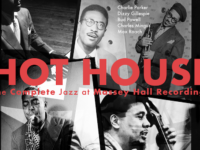Like the most artistically successful avanteers such as Mingus, Kirk and Braxton, the German composer, arranger and pianist Heiner Stadler fully understands, appreciates and loves the more traditional forms of jazz, using the older forms as a foundation to construct shining, new buildings of uber-modern architecture. Moreover, given Stadler’s abilities to direct ensembles large and small to move freely between improvised and scored sections in such a coalesced manner, it’s nearly impossible to tell when they are reading from the sheet music and when they’re just playing extemporaneously.
Such are the skills he brought to one of only a handful of projects recorded under his own name and even fewer released stateside, Tribute To Monk And Bird. At a time when jazz was on life support and last rites were being administered to avant garde jazz, Stadler made a daring move in assembling some of the best jazz musicians of the time (some of whom are among the best living today) for a tribute album to the music of bebop pioneers Charlie Parker and Thelonious Monk: three songs by Parker and three by Monk. Back in 1978, jazz albums celebrating the works of certain artists weren’t that common, so this was yet another strike against such a record ever getting any attention. Stadler didn’t play on this record and wrote none of the songs (obviously), but the most daring part about this undertaking comes from his arrangements that deconstructed the songs and built them up again as radical inventions. The Down Beat critic Jerry de Muth wrote at the time of release that the recordings were “far more than arrangements – re-compositions would be a better word.”
Even if you are very well acquainted with these songs by two of the largest figures in bebop, these songs—every single one of them—will be major revelations to you. The harmonic structures of the Bird and Monk’s compositions are the sole ideas that prevent the music from devolving into anarchy, and Stadler used these compositions as constraints that he relentlessly kept bumping up against, as if to test the harmonic limits of them.
For these January, 1978 sessions in NYC, Stadler brought together many of the finest the city had to offer. Stanley Cowell (piano), Reggie Workman (bass) and recent SER Sitdown subject Lenny White (drums) formed the core trio. Augmenting them were Thad Jones (cornet, flugelhorn), George Adams (tenor sax, flute) and George Lewis (trombone). Warren Smith dropped in to play timpani on a couple of tracks and Cecil Bridgewater’s trumpet replaced Thad Jones on one cut, “Ba-lu Bolivar Ba-lues-are.”
Many, if not all of the songs, drop hints of the melody that are sometimes imperceptible except from listening closely. Take “Straight No Chaser,” for instance, which only expressly states the theme about three minutes in. In the intro, if you want to call it that, a fragment of the theme is played and repeated a few times, as just one of many pieces that fits into the tapestry of sound. Later on, Workman does revisit it in full, but he plays it against the grain of what everyone else is playing. Cowell’s creative variation of the theme, coming shortly after Workman, is transcendent.
Stadler’s “Au Privave” retains the rhythm and cadence of the song, but melody is transformed into a dissonant facsimile of the original. George Lewis’ trombone performance is the star of this song, though, an aggressive, rangy recital that sounds like no other ‘bone player.
Stadler has his all-star crew employ a whole assortment of other devices all over the album, like playing the theme simultaneously but in different keys, slightly overlapping the solos, varying the tempo, emitting blasts of group improvisation, and liberally swapping around the roles of the players. I could probably write a small book breaking down the creative tricks used in each of these six performances, which were long enough to span four vinyl sides, but the original liner notes by the late jazz journalist Robert Palmer does a bang-on job revealing just what Stadler had plotted for the compositions.
In the end, Tribute To Monk And Bird winds up being more of a tribute to the prowess and imagination of Heiner Stadler, not to mention the facility of each of the participants. In spite of all the praise that greeted it on original release by Tomato Records (de Muth gave it the full five stars), it remains lightly noticed. Hwwever, last April, Labor Records reissued it by offering it on compact disc for the first time, with remixing by Malcolm Addey. With jazz and avant garde jazz still finding a limited audience but also given the ability of the internet to better reach that limited audience, Labor’s reissue at least provides a chance that the risk taking Heiner Stadler took thirty-three years ago can finally be appreciated by more of those with an interest in challenging music.
[amazon_enhanced asin=”B004P96WCM” /] [amazon_enhanced asin=”B00004ZEGM” /] [amazon_enhanced asin=”B0040JDA86″ /] [amazon_enhanced asin=”B000S3IOH0″ /] [amazon_enhanced asin=”B002QQ8H8I” /]
- Nick Millevoi – ‘Moon Pulses’ (2024) - April 23, 2024
- Cannonball Adderley – ‘Poppin’ in Paris: Live at L’Olympia 1972′ (2024) - April 20, 2024
- Christian Marien Quartett – ‘How Long Is Now’ (2024) - April 18, 2024



